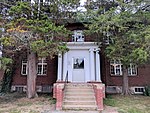Governor Baxter School for the Deaf
Boarding schools in MainePublic K–12 schools in the United StatesPublic boarding schools in the United StatesPublic elementary schools in MainePublic high schools in Maine ... and 4 more
Public middle schools in MainePublic schools in MaineSchools for the deaf in the United StatesSchools in Cumberland County, Maine
The Governor Baxter School for the Deaf (GBSD), formerly known as the Maine School for the Deaf is a public co-educational school that serves the deaf and hard-of-hearing in the State of Maine. It is located on Mackworth Island, an approximately 100-acre (40 ha) island in Falmouth, Maine, USA, adjacent to its border with Portland, Maine. Students who live far away may stay with host families, who provide residential services. Its program is the Maine Educational Center for the Deaf and Hard of Hearing (MECDHH).
Excerpt from the Wikipedia article Governor Baxter School for the Deaf (License: CC BY-SA 3.0, Authors).Governor Baxter School for the Deaf
Andrews Avenue,
Geographical coordinates (GPS) Address Nearby Places Show on map
Geographical coordinates (GPS)
| Latitude | Longitude |
|---|---|
| N 43.6907317 ° | E -70.2318515 ° |
Address
Andrews Avenue
04105
Maine, United States
Open on Google Maps









